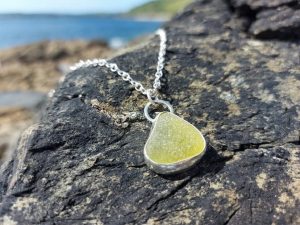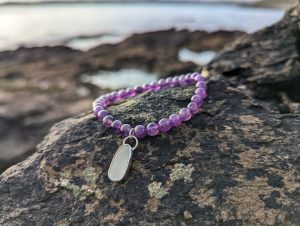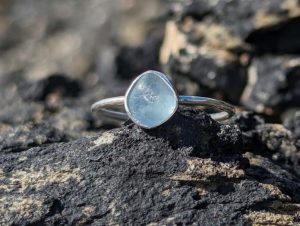Where to find Sea Glass in Cornwall?
Sea glass is a beloved treasure that can be found along beaches around the world. It refers to pieces of glass that have been smoothed and frosted by years tumbling in the ocean. Over time, the glass loses its sharp edges and becomes soft and clouded. Many sea glass hunters find the muted, matte colors and smooth feel highly appealing.
The coasts of Cornwall in the southwest of England are especially fruitful hunting grounds for sea glass. The rugged shores along the English Channel and Celtic Sea receive a constant barrage of strong waves that quickly soften glass. Historic coastal shipwrecks and waste dumping also contributed abundant glass to Cornwall’s shores over the past centuries.
Sea glass collecting has become a popular hobby along the Cornish coast. The array of rare and unusual pieces washing up continue to draw glass collectors from around the world. There’s a sense of excitement when combing the beaches, hoping to uncover a rare gem or particularly beautiful piece.
What Makes Good Sea Glass Beaches
Sea glass is formed when pieces of glass end up in the ocean and are tumbled and smoothed by the waves and sand over many years. Certain conditions make some beaches better than others for finding sea glass.
The best sea glass beaches have a combination of the right wave action, currents, and beach material. Waves tumble and break glass against the sand and rocks, so beaches with more active waves tend to produce more sea glass. However, if the waves are too strong, the glass can get buried or smashed instead of gently smoothed.
Beaches where currents converge bring in glass that has floated from various locations. This concentrates and deposits sea glass that may have originated far away. Longshore drift currents that run parallel to the beach also carry and deposit glass pieces.
The composition of the beach matters too. Pebbly beaches with rocks and gravel help abrade and smooth glass. Beaches with coarse sand can also polish glass over time. The smoothest sea glass is often found on beaches with fine sand that buffs the edges.
The shape of the beach can also create conditions for depositing sea glass in certain areas, like coves where glass can accumulate in eddies and swirls. Knowing what makes a good sea glass beach helps narrow down the best places to start searching.
Best Beaches For Finding Sea Glass
Cornwall has many excellent beaches for finding sea glass. Here are some of my favourites:
Gyllyngvase Beach 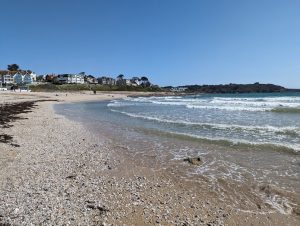
This is one of my favourite beaches on the South Coast. I’ve found many pieces here that I have turned into sterling silver rings and pendants, but its also quite popular so head out early as the tide is going out. It also has a lovely cafe on the beach to treat yourself to something tasty!
Porthtowan Beach
This Blue Flag beach has plenty of smooth multi-colored glass pieces. Check along the high tide line as well as sandy patches up the beach. It faces southwest so sea glass gets deposited especially after storms.
Praa Sands Beach
This family-friendly beach has a mix of sand and pebbles, making it great for sea glass. Look along the tide line and in rocky areas exposed at low tide. Southwest winds push glass ashore so it’s a reliable spot.
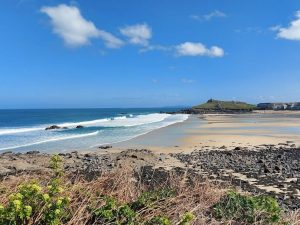 Porthmeor Beach
Porthmeor Beach
This expansive beach located in St Ives is one of the best for sea glass hunting. Strong currents and waves bring in glass that gets naturally tumbled in the surf. Walk along the shoreline looking in the wrack line and in patches of seaweed. Early morning is best after high tide has receded, always check the tide times before heading down.
Porthcurno Beach
Located near Land’s End, this sheltered beach has a submarine telegraph cable running offshore, contributing glass pieces. Walk along the high tide line on the east side. Low spring tides reveal more glass. Go after storms for fresh deposits.
Porthkidney Beach
This secluded beach near Lelant has patches of coarse sand and rock pools for beachcombing. Check the high tide wrack line as well as along the rocky outcroppings at each end. An onshore breeze blows glass in regularly so it’s consistently good.
Other great beaches include Pentewan Sands, St Austell, Portreath, St Agnes, Marazion & Sennon Cove.
Where to Look
The best places to find sea glass are along the high tide line and the incoming tide line. When searching for sea glass, focus your efforts on:
-
The high tide line, which is marked by debris, seaweed, and shells deposited by the highest point the tide reached. This is often the first place waves deposit new pieces of sea glass.
-
The incoming or advancing tide line, which is where waves are actively moving onto the shore. New pieces of sea glass may be tumbling in with the waves. Walk along the edge of the water and keep an eye out.
-
Near structures that trap sea glass, like rock jetties, wooden groins, and concrete sea walls. Sea glass tends to collect in corners and eddies around these structures.
-
Areas where the shoreline changes direction or forms coves, which create eddies that trap sea glass.
-
Spots where small streams meet the ocean, as the flowing water can carry glass shards down to the beach.
The best strategy is to walk methodically along the high tide line and incoming tide line, scanning the sand for any hint of color or glint of glass. Sea glass often blends into the sand and pebbles, so look carefully. When you spot a piece, search the surrounding area as more fragments may have accumulated nearby.
When to Go
The best times of day and year for spotting sea glass depend on several factors.
Time of Day
Early morning, especially around sunrise, is often ideal for sea glass hunting. When the tide is going out, revealing more beach area, and the morning light will help the glass stand out against the sand. Late afternoon or evening can also work well when the tide is low.
Avoid midday, when the sun is high overhead. The bright glare and shadows make it much harder to distinguish sea glass. Go during the “magic hours” of sunrise or sunset for the best visibility.
Time of Year
It’s best to search after storms and high winds, which churn up the waves and deposit more sea glass on shore. Autumn and winter storms bring plenty of new treasure to the beaches.
Spring is another fruitful time, as calm conditions allow smaller shards to wash in. Late summer can be good too due to more beach visitors losing items.
Avoid summer, when beaches are crowded. Go during the off-season when there is less competition for finds.
Tides and Weather
Ideally, go at low tide after a storm. Low tide exposes more beach to comb through. Storms break glass into smaller pieces and toss it ashore.
Avoid going during or just after heavy rain, as flooding and high waves can wash the glass away again before it’s found.
Check tide tables and weather forecasts for your best timing. Early morning low tides after stormy nights are often the jackpot!
Tips and Tricks
Searching for sea glass takes patience and persistence. Here are some tips to improve your chances of finding beautiful frosted shards along the Cornish coast:
Use a shovel or trowel – A small shovel or garden trowel can be extremely helpful when sifting through pebbles and sand. The metal edge makes it easier to scoop and sort through debris. Sturdy plastic sand toys work too. This prevents you from needing to crouch down and sort through rocks by hand.
Look after rain – Stormy weather stirs up the shoreline, bringing more sea glass to the surface. Search shortly after a heavy rain, windstorm or unusually high tide. More glass gets unearthed and washed ashore.
Search in the early morning – Arrive at the beach in the early morning hours, before others have picked through. The glass won’t get spotted and snatched up by other seekers. The low angle of morning light can also make sea glass easier to spot.
Safety
When hunting for sea glass, it’s important to keep safety in mind. The ocean can be unpredictable, so you’ll want to take some basic precautions.
-
Check tide times before heading out. Make sure you won’t get stranded or caught off guard by incoming tides. Use a tide table or app to know when the tides will shift.
-
Wear appropriate footwear. Flip flops won’t cut it on slippery rocks and uneven terrain. Opt for shoes or boots with good traction that will protect your feet. Water shoes work well.
-
Be aware of your surroundings. Keep an eye out for rogue waves and changes in weather. Don’t get so absorbed in looking for treasure that you ignore potential hazards.
-
Watch your step. Seaweed and wet rocks can be quite slippery. Move slowly and use caution near the water’s edge.
-
Have a plan. Know your route and how to get help if needed. Consider hunting with a buddy for added safety.
-
Check weather and surf reports. Don’t go out in dangerous storm conditions or high surf.
Following basic precautions will help ensure your sea glass quest is safe as well as fruitful. Stay alert and use good judgment when beachcombing.
Etiquette
When hunting for sea glass, it’s important to be respectful of the beach environment. Here are some tips for proper sea glass hunting etiquette:
-
Leave the beach as you found it. Don’t disturb wildlife, plants or rocks while searching. Fill any holes you dig and try to leave minimal impact.
-
Be respectful of wildlife. Never harass birds, seals or other animals you encounter. Give them space and admire from a distance.
-
Follow beach rules. Many beaches have regulations, so be sure to check for signs and abide by any access restrictions or bans on removing natural materials.
-
Take your rubbish with you. Make sure you leave nothing behind, including food wrappers or bags. The beach should look untouched when you leave.
-
Watch your step. Be careful not to trample dunes, grasses or nesting areas. Stick to the hardest-packed areas of sand near the surf.
-
Share the beach. Be courteous of other beachgoers, whether they’re swimming, sunbathing or also hunting for treasure.
Following these simple etiquette rules helps preserve the natural beauty and accessibility of the beaches for all to enjoy. With some care and common courtesy, we can keep the beaches pristine while still collecting these unique frosted gems.
Identifying Valuable Sea Glass
Sea glass often comes in common colors like white, brown, and green. But more rare colors of sea glass can be quite valuable to collectors. Here are some of the rarest and most valuable sea glass colors to look out for:
Rare Reds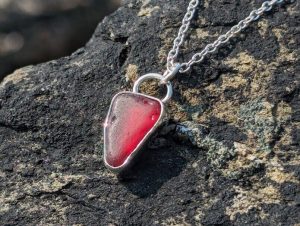
Red is one of the rarest sea glass colors. Cobalt red and cranberry red sea glass are very desirable and can often be listed on some marketplace’s. Look for rounded pieces of opaque red glass.
Vibrant Blues
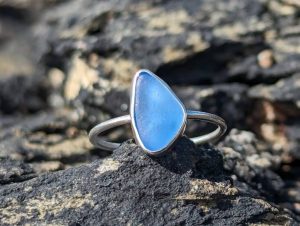 Cobalt blue and teal blue sea glass is rare and commands high prices. These dark, rich blues are uncommon because few glass objects were made in these shades.
Cobalt blue and teal blue sea glass is rare and commands high prices. These dark, rich blues are uncommon because few glass objects were made in these shades.
Glowing Yellows
Most yellow sea glass is actually a greenish color, but true yellow and amber sea glass is rare. Vintage uranium glass and Vaseline glass in yellow is also quite valuable.
Opaque White
Milk glass and opaque white sea glass is also prized by collectors. Look for thick, rounded white pieces without bubbles or discoloration.
With patience and a bit of luck, you may uncover a valuable piece of sea glass in a rare color! But rarity does not guarantee value – color, clarity, condition and shape also affect price.
Happy Hunting & Be Safe!!
CHECK OUT SOME OF THE JEWELLERY I’VE MADE WITH THE SEA GLASS FOUND ON THE CORNISH COAST
